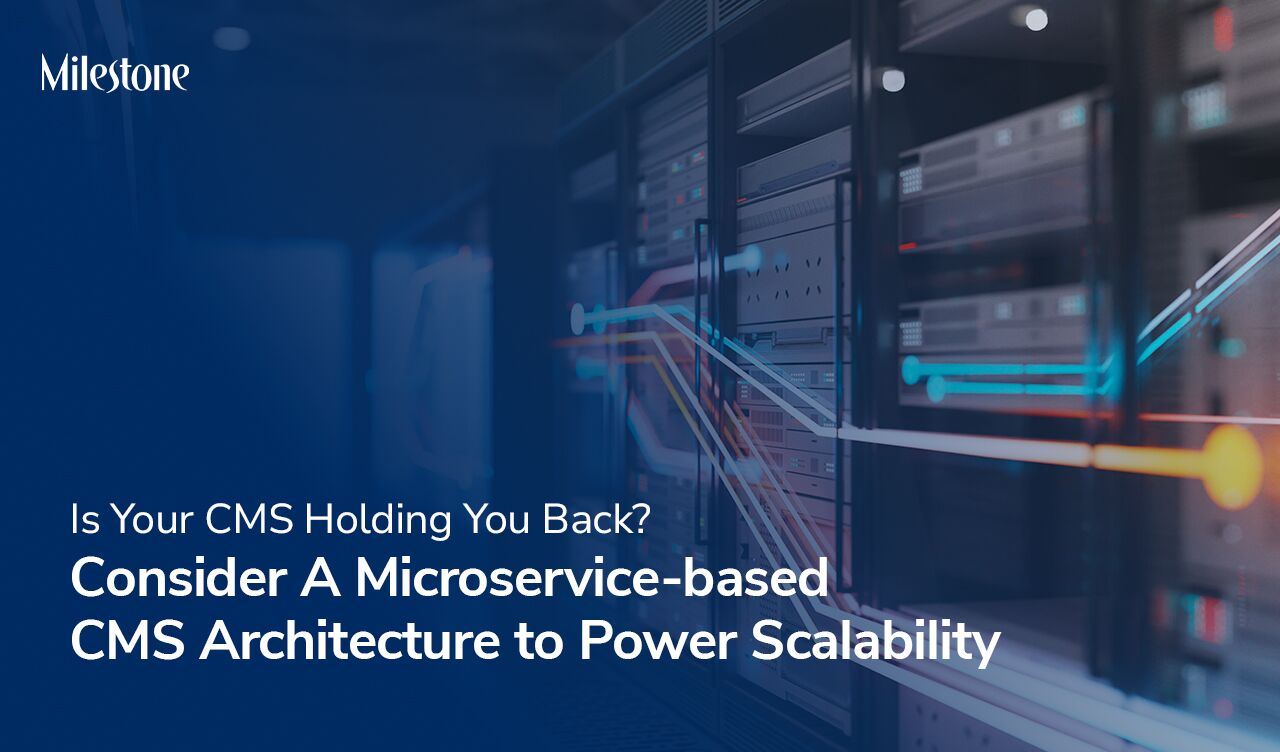Choosing a CMS is beyond just content management, it’s selecting the architecture that underpins your scalability, availability, performance, and security – ultimately shaping the website experience you deliver across networks.
With traditional monolithic architecture posing severe limitations to the aforementioned aspects of scalability, availability, etc., thereby proving to be costly and hurting the profitability of businesses, it’s time to look at the microservices architecture that helps drive scalability.
In this article, we’ll walk you through the key architectural considerations your business needs to make while highlighting the current challenges faced by businesses and how Milestone CMS’ architecture addresses them.
When selecting a CMS, the initial consideration typically revolves around speed to market in enhancing digital experiences, facilitated by features such as:
Architectural considerations when choosing a CMS
- Authoring & Publishing tools: Streamlined content ideation and creation with Gen AI and publishing tools.
- Centralization & Workflow: Asset Manager for centralization, optimization, and workflow moderation.
However, beneath the capabilities of scalable content creation and global website delivery lies the core of microservices, which support availability, scalability, usability, security, and other essential aspects. Let’s explore how these microservices bolster cost-efficiency and profitability through their unwavering reliability.
- Availability, Performance, & Scalability: Downtime is revenue death!
A poor CMS architecture can lead to scalability issues causing slow or non-existent customer experiences during traffic surges. Single system failures can cascade into widespread outages, disrupting online operations and negatively impacting revenue streams – as is the case with monolith architectures. Addressing these challenges requires a paradigm shift in line with the MACH (Microservices, API-driven, Cloud-Native, Hybrid/Headless) architecture.
By using a CMS that leverages cloud-native principles such as microservices, API-first design, and hybrid-headless architecture, businesses can ensure a robust CMS experience. For instance, at Milestone, we employ automatic redundancy and failover mechanisms, including a geographically distributed multi-availability zone CDN, to minimize downtime and mitigate disruptions. Our CMS services are deployed across multiple nodes, utilizing virtual machines and Kubernetes pods, ensuring even load distribution and enhancing fault tolerance.
Think about business operations that experience seasonal fluctuations, with traffic surging during peak periods such as Black Friday, New Year, Seasonal Offers, or Paid Campaigns. Provisioning websites solely for peak traffic results in underutilization and increased operational costs during off-peak periods. Conversely, building for average traffic can lead to performance issues during surges. Thus, websites must dynamically auto-scale based on real-time traffic demands to ensure optimal performance and cost-effectiveness.
Milestone CMS addresses this challenge through its microservices architecture and elastic scaling capabilities. By dynamically allocating resources to meet traffic spikes, we prevent performance bottlenecks and maintain optimal website performance. Advanced disaster recovery features such as multi-region deployment and automated failover further enhance resilience, ensuring continuous service availability.
To summarize, with Milestone CMS, businesses can navigate traffic fluctuations seamlessly while maintaining optimal performance and cost-effectiveness.
- Usability: Offering a fast and seamless content delivery experience
Website visitors span the globe and expect swift, smooth user experiences. Consequently, businesses must swiftly deliver content to browsers and devices worldwide. The solution? Bring content closer to users through Content Delivery Networks (CDNs).
Milestone’s CMS published the sites by integrating seamlessly with CDN providers, leveraging their global network of servers to cache and deliver content closer to end-users. This integration ensures that users worldwide experience fast and consistent page load times, regardless of their location.
An inherent challenge with CDNs is the timely propagation of content changes across all caches when modifications occur on the source site. This process is prone to delays or oversights. However, Milestone CMS addresses this issue through an intelligent cache management service, ensuring swift content delivery across the CDN within minutes through seamless API integrations.
- Security: Taking the fight against cyber attacks
Security breaches pose a significant threat to businesses, especially when it comes to sensitive data such as ‘personally identifiable information’ of customers. A single breach can have severe consequences, including financial losses, damage to reputation, and legal ramifications. Therefore, it’s crucial for businesses to prioritize security and ensure that their infrastructure is equipped to handle potential threats effectively. We’ll explain how we do it.
Firstly, robust security measures are essential, including a Web Application Firewall (WAF) deployed at both the CDN and server levels, coupled with effective data encryption protocols for data in transit and at rest. Additionally, the architecture of Milestone CMS enhances security by segregating various components and functionalities into independent services or microservices. This modular design reduces the attack surface, limiting the scope of security breaches and preventing their propagation across the entire CMS infrastructure.
Secondly, Milestone CMS adopts an API-first design, which enables controlled and authenticated access to CMS functionalities. By implementing robust authentication and authorization mechanisms, Milestone ensures that only authorized users and applications can interact with the CMS, reducing the risk of unauthorized access and data breaches.
Additionally, the cloud-native nature of Milestone CMS enhances security by leveraging advanced security features provided by cloud service providers. These features include encryption at rest and in transit, identity management, and intrusion detection systems, which bolster the overall security posture of the CMS infrastructure.
Conclusion
In conclusion, having a strong architecture to back your content and help you drive digital experiences is imperative from the point of offering the best possible website experiences as well as being cost-optimal. When choosing a CMS that will efficiently help you scale, consider the architecture and points mentioned above.
Stay tuned as we explore in-depth the various factors that businesses must consider when selecting a CMS architecture in our upcoming articles. We will unravel the ideal infrastructure and its capabilities, empowering you to drive unparalleled digital experiences.
